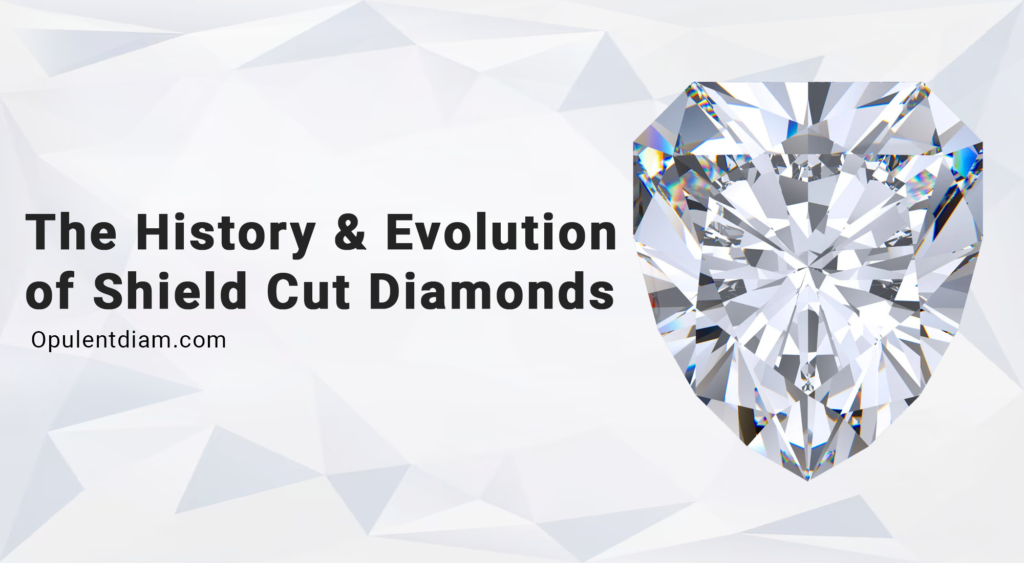
The History & Evolution of Shield Cut Diamonds
Diamonds have enchanted those who wear jewelry for centuries and given the meanings attributed to them and their craftsmanship. Of all the many cuts that have been created through the years, shield cut diamonds have always been a classic and elegant choice.
With its geometric beauty and rich history, the diamond cut has become a preferred style for collectors and contemporary jewelry enthusiasts. But what is a shield cut diamond? Find answers to the questions in this blog.
Origins of the Shield Cut Diamond
The name shield cut diamonds was derived from medieval heraldic shields that represent strength, protection, and nobility. Its origin dates back to the early history of diamond cutting when artists tried to vent out the brightest brilliance of the rough stone without deforming its natural shape.
As compared to modern-day mass-produced brilliant cuts, shield cut diamonds were initially hand-faceted with facets that were designed to show their original beauty rather than adhering to strict geometric patterns.
In the Renaissance period, diamond cutters mastered their craftsmanship, and shield cut was the fashion cut worn by royals. The latter, therefore, found its placement within crowns, ceremonial sabers, as well as nobs’ heraldic devices, linking it with prosperity and might.
Renaissance and Baroque Periods
Antique shield cut diamonds were commissioned in ornamental jewelry pieces during the Renaissance period (14th–17th century) by royal families in Europe. Cutting at these times was yet to be developed in terms of technology and was hence asymmetrical in shape. The diamond must be set in a high-karat gold mounting, together with the enamel and other gems that uphold it, to make it more appealing.
During the Baroque era (17th–18th centuries), jewelry designs became more complex in their metalwork and had flamboyant gem settings. Shield cuts were found in church decorations, pendants, and brooches. Shield cuts were commonly seen in church ornaments, pendants, and brooches. Because of their equilibrious but unorthodox disposition, they were most appropriately suited for display objects, particularly in religious and royal life.
Georgian and Victorian Eras
In the Georgian period (1714–1837), diamond cutting improved considerably, creating more sophisticated shield cut diamonds. Diamonds were more often contained in closed-back settings in order to multiply their brilliance with the help of foilbacks. The cut gained popularity for use in sentimental jewelry, such as mourning rings and lockets.
During the Victorian period (1837–1901), greater usage of industrial methods of cutting diamonds gave rise to more symmetrical and accurate shield cut diamonds. The fashion statement set by Queen Victoria for romantic ornaments gave rise to the popularity of odd shapes in individual stones, such as shield cuts, worn on brooches and wedding rings.
Mid-Century & Modern Revival
The glory years of glamour in Hollywood, which spanned the 1940s to the 1960s, nurtured a craving not just for the extraordinary but also for exotic diamond types. Among them were the fantastic shield-cut diamonds caught between unique cocktail rings, gorgeous earrings, and innovative jewelry designs.
Over the last few decades, shield-cut diamonds have found a new lot in the current jewelry market owing to their ‘great architectural’ beauty and their modern looks. They appeared in distinctive cocktail rings, striking earrings, and avant-garde jewelry creations.
Modern Uses of Shield Cut Diamonds
The shield cut diamond is now highly valued for its dramatic yet elegant look. Shield cuts are seen quite frequently in:
- Engagement Rings: Providing a classic alternative to the fashionable round or princess cut.
- Earrings: Shields as studs or drops with a geometric look.
- Necklaces & Pendants: They tend to be discovered in plain or vintage-styled frames.
- Mixed-Cut Jewelry: Apart from that, there are rounds, switches, baggies, or trillions for that new-age look.
A shield cut diamond is an accent gemstone employed by most custom jewelers in those special settings, giving it a distinctive modern touch but retaining the traditional vintage charm.
Read More: Find Out Some Helpful Tips to Buy the Ideal Pair of Matching Diamonds
How to Select a Shield Cut Diamond Ring
The highlights to be born in mind when looking at a shield cut diamond ring are as follows:
Cut Quality: Select symmetry and well-proportioned balance, for it contributes a lot to brilliance. Opt for sharp, definite edges and even cutting to yield most of the light.
Size & Carat Weight: While choosing your ring setting, keep in mind that shield cuts look larger compared to equally weighed diamonds because they have a rectangular shape.
Clarity: The big facets on shield cuts cause inclusions to be seen better. Select an upper level of clarity (VS2 and higher) to create maximum brilliance.
Color: Color choice is a personal preference, but near-colorless diamonds (G-H color grade) are a reasonable compromise between quality and value.
Setting Style: Bezel settings optimize durability and provide an antique appearance. Prong settings provide maximum light exposure and optimize brilliance. Halo settings provide additional fire and a high-end look.
Certification & Authenticity: Always buy diamonds with a grading report from a credible gemological laboratory (GIA, AGS, IGI) for the guarantee of quality and genuineness.
Conclusion
Shield cutting dates back several centuries, from a princely ornament to the present-day darling in jewels. From Renaissance-age antique shield cut diamond ornaments to modern shield cut diamond engagement rings, this rare shape will continue fascinating those collecting jewelry due to its uniqueness. Trendy with shield cut diamond jewelry with each new generation is something this old cut type keeps from tales of history and modern expertise.
If you want to have a historic flavor mixed with sophistication and great bold design, then you must go for that unique shield cut diamond!
Read More: Understanding the Carre-Cut Diamond: A Complete Guide